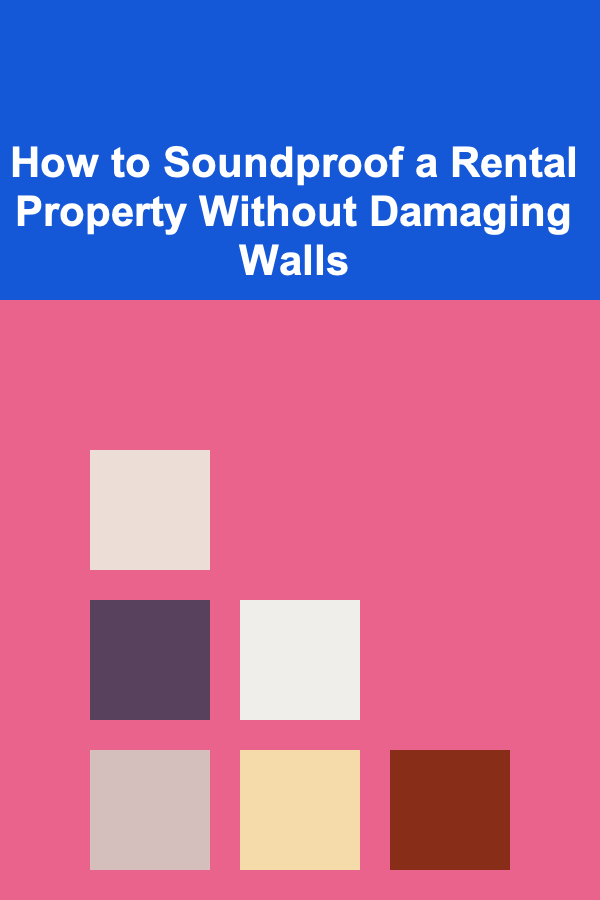
How to Soundproof a Rental Property Without Damaging Walls
ebook include PDF & Audio bundle (Micro Guide)
$12.99$9.99
Limited Time Offer! Order within the next:

Living in a rental property can be a challenge when it comes to soundproofing. Whether you're trying to block out the sounds of neighbors, street noise, or create a quieter environment for work, study, or leisure, achieving effective soundproofing can seem like an impossible task, especially when you're not allowed to make permanent changes or damage the walls. Fortunately, there are numerous creative and temporary methods you can employ to soundproof your rental space without violating lease agreements or damaging the property. This article will provide an in-depth guide to soundproofing a rental property, offering practical, easy-to-implement solutions.
Understanding the Challenges of Soundproofing a Rental Property
Before diving into the solutions, it's essential to understand why soundproofing can be challenging in a rental property. Unlike owning a home, renters have limitations when it comes to making alterations. Most landlords prohibit significant changes like adding additional layers of drywall or installing permanent soundproofing solutions. As a result, renters must rely on temporary or non-invasive methods that still deliver effective results.
The two main challenges you may face when soundproofing a rental property are:
- Restrictions on making permanent changes: Many landlords have strict rules about alterations, and soundproofing typically requires changes that could damage the walls, floors, or ceilings.
- Structural limitations: Rental properties often lack the advanced materials or construction techniques that are typically used in soundproofing, such as double-layered walls, soundproof insulation, or floating floors. These limitations make it harder to address soundproofing issues directly.
Despite these challenges, it is still possible to reduce noise levels and create a more peaceful living environment with the right approach.
Identifying the Sources of Noise
Before implementing soundproofing methods, it's important to identify the sources of noise in your rental property. Sound can travel in a variety of ways, and understanding the specific type of noise you're dealing with will help determine the most effective solutions. The main types of noise include:
- Airborne noise: This type of noise travels through the air and is typically caused by talking, music, television, or other human activities.
- Impact noise: This type of noise occurs when something strikes a surface, causing vibrations. Footsteps, furniture being moved, or dropping objects can all cause impact noise.
- Structural noise: Sound can travel through the building's structure, such as floors, walls, or ceilings. This is often a result of vibrations from heavy machinery or even noisy neighbors above or below.
Once you identify the source of the noise, you can tailor your soundproofing efforts accordingly.
Non-Permanent Soundproofing Solutions for Walls
The walls in your rental property are often the primary culprits when it comes to sound transmission. While you can't add layers of drywall or insulation, there are several methods you can use to reduce sound leakage without damaging the walls.
1. Use Soundproof Curtains or Drapes
Soundproof curtains, often made of dense materials like velvet, wool, or mass-loaded vinyl (MLV), are an excellent solution for renters. These curtains help absorb sound, reduce echo, and block out external noise. To maximize their effectiveness, choose curtains that are thick and cover the entire wall from ceiling to floor.
- Advantages: Easy to install with no permanent changes, highly effective at blocking airborne noise, especially for windows.
- Disadvantages: Might not work as well for thick walls or structural noise, and can be less effective for high-frequency sounds.
2. Apply Acoustic Panels
Acoustic panels are designed to absorb sound waves and reduce reverberation. Many acoustic panels are designed to be mounted temporarily and can be removed without damaging the walls. They come in various forms, including foam panels, fabric-wrapped panels, and fiberglass panels.
- Advantages: Effective at absorbing mid to high-frequency sounds and improving room acoustics.
- Disadvantages: These panels work best when installed at reflection points, and may not block all types of noise.
3. Use Foam Wall Tiles
Foam wall tiles are another non-permanent option to help reduce noise in your rental property. These tiles are designed to absorb sound and improve the acoustics of a room. They come in various patterns and sizes, and they can be easily affixed to walls using removable adhesive strips or double-sided tape.
- Advantages: Affordable, easy to install, and removable.
- Disadvantages: May not block low-frequency sounds as effectively as other materials.
4. Install Temporary Wall Panels
If you want more substantial soundproofing, consider using temporary wall panels. These panels are made of materials like foam, cork, or even fabric-wrapped boards that can be mounted on the wall using non-permanent adhesive strips or hooks. They can help block sound transmission and reduce noise from neighbors or the outside environment.
- Advantages: Provides more coverage than curtains or foam tiles and can help with both airborne and impact noise.
- Disadvantages: Requires a bit more effort to install and remove compared to curtains, and they may not fully eliminate sound leakage.
5. Seal Gaps and Cracks
Even small gaps or cracks in the walls, window frames, or around doors can allow sound to travel through. To reduce sound leakage, use acoustic caulk to seal any visible gaps in your walls, windows, or doors. This solution is simple, inexpensive, and completely reversible.
- Advantages: Inexpensive, effective at sealing small gaps that may let in noise.
- Disadvantages: Does not address larger sound transmission issues or structural noise.
Soundproofing Floors Without Damaging the Surface
Floors are another common source of noise, especially when you live in an apartment or multi-story building. Sound can travel through the floor and disturb neighbors or anyone in rooms below. While permanent floor installations are not an option in a rental property, there are several methods to reduce floor-related noise.
1. Use Area Rugs and Carpets
One of the simplest ways to reduce noise from the floor is to use thick area rugs or carpets. Rugs can absorb sound and prevent impact noise, such as footsteps, from traveling through the floor. For maximum effectiveness, place a thick rug with a dense underlay in high-traffic areas, such as the living room or hallway.
- Advantages: Affordable, easy to install, and movable.
- Disadvantages: Not as effective for reducing airborne noise, and rugs may not provide much soundproofing for lower frequencies.
2. Install Rubber Mats or Soundproof Underlayments
If you're looking for a more effective soundproofing option, consider rubber mats or soundproof underlayments. These materials are designed to absorb vibrations and reduce impact noise. Many soundproof underlayments are also designed to be laid beneath carpets or rugs without causing damage to the floor.
- Advantages: Highly effective at reducing impact noise and vibrations.
- Disadvantages: Can be expensive and may require rearranging furniture to cover large areas.
3. Use Temporary Floor Coverings
For a more DIY approach, consider using temporary floor coverings like foam mats or carpet tiles. These mats are typically easy to install and can help reduce both impact and airborne noise. They are designed to interlock and can be easily removed when you move out of the rental property.
- Advantages: Easy to install, inexpensive, and removable.
- Disadvantages: May not be as effective as rubber mats or underlayments, and can create an uneven surface if not installed properly.
Soundproofing Windows Without Permanent Changes
Windows are another weak point when it comes to soundproofing in a rental property. Noise from outside, such as traffic, construction, or noisy neighbors, can easily penetrate through windows. While replacing windows with double-pane glass is an expensive and permanent solution, there are several non-permanent alternatives you can try.
1. Use Window Plugs
Window plugs are custom-fitted foam panels that you insert into your window frames to block out noise. They work by creating an additional barrier that prevents sound from entering through the glass. They are easy to install and remove, making them an excellent temporary solution.
- Advantages: Highly effective at blocking airborne noise, easy to install and remove.
- Disadvantages: May not look aesthetically pleasing and can block natural light.
2. Install Soundproof Window Inserts
Soundproof window inserts are a more advanced solution that involves placing an acrylic or laminated insert over the window. These inserts provide an additional layer of sound insulation and can dramatically reduce outside noise. Some products are removable and can be installed without damaging the window frame.
- Advantages: Very effective at blocking outside noise, can be removed when you move.
- Disadvantages: Expensive compared to other methods.
3. Use Heavy Curtains
Thick, heavy curtains made of materials like velvet, wool, or MLV can help block sound from entering through the windows. The thicker the curtain, the better it will be at absorbing sound. To maximize their effectiveness, hang curtains that cover the entire window frame and extend to the floor.
- Advantages: Affordable, easy to install, and highly effective for blocking airborne noise.
- Disadvantages: May not be as effective for low-frequency sounds, and can block natural light.
Additional Tips for Soundproofing a Rental Property
In addition to the methods mentioned above, there are a few other strategies you can use to further reduce noise in your rental property.
- Create a Quiet Zone: Set up a designated quiet space in your rental property where you can focus, relax, or sleep without being disturbed by noise. Choose a room that is far from high-traffic areas and install noise-blocking solutions like curtains, rugs, and acoustic panels.
- Use White Noise or Sound Machines: White noise machines can help mask unwanted sounds and create a consistent, soothing background noise. This can help drown out external disturbances, such as traffic or conversations from neighbors.
- Furniture Placement: Strategically placing furniture against walls can help absorb sound and reduce noise transmission. For example, bookshelves, large couches, or even a heavy dresser can serve as a barrier to sound.
Conclusion
Soundproofing a rental property without damaging the walls is entirely possible with the right approach and the use of temporary solutions. By identifying the sources of noise and utilizing non-permanent methods such as soundproof curtains, acoustic panels, rugs, window plugs, and other sound-absorbing materials, you can significantly reduce unwanted noise and create a more peaceful living environment. Whether you're trying to block out external disturbances or create a quiet, acoustically pleasant space, these solutions will help you achieve your soundproofing goals without violating your lease agreement.
Reading More From Our Other Websites
- [Home Holiday Decoration 101] How to Create a Stunning Holiday Wreath for Your Front Door
- [Gardening 101] The Ultimate Guide to Testing Garden Soil pH: Tools, Techniques, and Tips
- [Personal Care Tips 101] How to Choose the Best Hair Mask for Your Hair Type
- [Reading Habit Tip 101] Creating a Cozy Reading Nook: Setting Up Your Space for Consistent Reading
- [Personal Finance Management 101] How to Budget for Irregular Income as a Freelancer
- [Hiking with Kids Tip 101] Easy Trails Under 5 Miles: Perfect Hikes for Children Ages 6-12
- [Personal Financial Planning 101] How to Teach Your Kids Financial Responsibility
- [Organization Tip 101] How to Organize a Mindful Garden or Plant Space
- [Organization Tip 101] How to Choose the Right Rugs for an Organized Living Room
- [Home Party Planning 101] How to Keep Guests Entertained on a Budget: DIY Solutions and Home Activities!

How To Choose Your Next Language to Learn
Read More
How to Create DIY Crafts with Kids Using Household Items
Read More
How to Maintain Your Home's Foundation to Avoid Expensive Repairs
Read More
How to Store Your Music Books by Genre
Read More
How to Use Game Design Talent to Make Money
Read More10 Advanced Tips for Optimizing Your HELOC Expense Tracking System
Read MoreOther Products

How To Choose Your Next Language to Learn
Read More
How to Create DIY Crafts with Kids Using Household Items
Read More
How to Maintain Your Home's Foundation to Avoid Expensive Repairs
Read More
How to Store Your Music Books by Genre
Read More